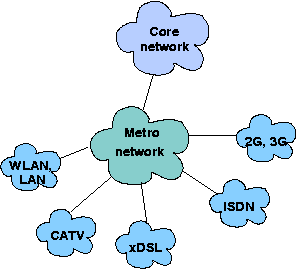Metropolitan Area Network(MAN)is a computer networks usually spanning a campus or a city, which typically connect a few local area networks using high speed backbone technologies. A MAN often provides efficient connections to a wide area network (WAN). There are three important features which discriminate MANs from LANs or WANs:
- The network size falls intermediate between LANs and WANs. A MAN typically covers an area of between 5 and 50 km range. Many MANs cover an area the size of a city, although in some cases MANs may be as small as a group of buildings.
- A MAN (like a WAN) is not generally owned by a single organisation. The MAN, its communications links and equipment are generally owned by either a consortium of users or by a network service provider who sells the service to the users.
- A MAN often acts as a high speed network to allow sharing of regional resources. It is also frequently used to provide a shared connection to other networks using a link to a WAN.
MAN adopted technologies from both LAN and WAN to serve its purpose. Some legacy technologies used for MAN are ATM, FDDI, DQDB and SMDS. These older technologies are in the process of being displaced by Gigabit Ethernet and 10 Gigabit Ethernet. At the physical level, MAN links between LANs have been built on fibre optical cables or using wireless technologies such as microwave or radio.
The Metropolitan Area Network (MAN) protocols are mostly at the data link level (layer 2 in the OSI model ), which are defined by IEEE, ITU-T, etc.

Protocol Structure - Metropolitan Area Network and MAN Protocols
The key MAN protocols and technologies are listed as follows:

No comments:
Post a Comment